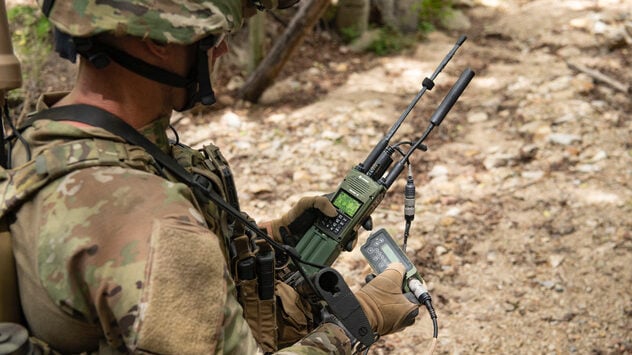ANDREW WHITE

LONDON — The British Army has made its largest tactical radio procurement in more than a decade, as it seeks to upgrade the connectivity of dismounted units operating on the ground and incorporate lessons learned from the conflict in Ukraine.
On Nov. 25, the UK Ministry of Defence (MoD) announced it had selected L3Harris Technologies to fulfil its Multi-Mode Radio (MMR) requirement, part of the Land Environment Tactical Communications and Information Systems (LE TacCIS) program.
The £90 million ($103 million) contract includes the delivery of more than 1,300 AN/PRC-163 handheld and AN/PRC-167 manpack software defined radios (SDRs) scheduled for delivery to the Army over the next several years. SDRs will replace L3Harris’s legacy AN/PRC-152 and AN/PRC-117G radios respectively, which have been in service with the British Army for over a decade.
According to L3Harris’s UK Regional Managing Director, Ian Blower, the British Army will use both SDR types to enable interoperability with international partners, as well as enhancing ground-to-air and tactical satellite communications.
To date, L3Harris has supplied several thousand “Type 3” SDRs to the Ukrainian Armed Forces, which US defense sources explained to Breaking Defense have been a significant capability for the ground forces as they continue to engage with the Russian Army in a highly contested operating environment. And those on-the-ground lessons are filtering back to L3Harris.
“We are learning lessons from that conflict. Users don’t want to be limited by a family of waveforms and the electronic threat,” Blower told Breaking Defense.
The British Army’s new SDRs will allow dismounted units the ability to run multiple, undisclosed waveforms which can, if necessary, be updated remotely and beyond line of sight. Specialist waveforms can be employed to reduce detection and/or interception of communications by enemy forces, for example.
L3Harris confirmed the MMR requirement is related to, but does not fall directly under the Morpheus “next generation tactical communication information systems for defence” program which is part of the wider LE TacCIS effort and has been plagued by delays over recent years. But according to L3Harris’ vice president and managing director Keith Norton, the MMR selection of AN/PRC-163/167 could have a significant effect on the type of “bearers” or SDRs selected for Morpheus.
Morpheus was originally announced in 2016 as a next-generation replacement for the Bowman tactical voice and data communications solution, which remains in service today. A competition for the selection of the Morpheus “Delivery Partner” is expected to run in 2023, which will then have significant input into future bearer requirements in support of that particular program.
“This is the first, new and modern radio purchased by the British Army for some time. As AN/PRC-163/167s enter into service, the army will have the opportunity to experiment with waveforms and consider various concepts of operation,” Norton stressed before suggesting these latest SDRs could be “easily” integrated into Morpheus at a later date.
L3Harris was selected by the MoD ahead of Ultra Electronics/Rafael Advanced Defense Systems and Thales/Collins Aerospace following extensive testing, defense sources told Breaking Defense.
The MMR is designed to support the future expeditionary requirements of the British Army, including early entry and small unit teams. According to L3Harris, major requirements fulfilled by AN/PRC-163/167s include interoperability with allied nations, flexibility in communication, and enhanced resilience for forward-deployed forces.
Speaking to Breaking Defense at the company’s UK headquarters in Farnborough, Norton said both SDRs would enable “land forces to easily communicate and interoperate with NATO and US allies and provide a solution that can be easily tailored for each deployment.”
A written statement by the MoD suggested the new SDRs would be used by mounted and dismounted personnel and also said “technical advances and upgrades will allow the [163 and 167] radios to work across a range of security classifications.”
Notably, both AN/PRC-163 and AN/PRC-167 SDRs are already in service with the US Department of Defense — Britain’s key military ally.
“It’s important to stress that these new radios are available today, off-the-shelf,” Norton said, before adding “The investment in these tried-and-tested radios will make for speedier deployments, faster decision-making, and improved soldier safety.”
The MMR contract also features additional options which would allow the British Army to add capability in the future, if required.
The 163 and the 167 feature the integration of specialist “mission modules’ which essentially make the two-channel SDR a three-channel radio. Current mission modules offered by L3Harris include ISR (intelligence, surveillance and reconnaissance) and Iridium (low earth orbit satellite communications) mission modules.
Initial deliveries of AN/PRC-163/167s to the army are expected before the end of the year with additional tranches scheduled over the next two years. SDRs are expected to be deployed operationally with the army in 2023 and beyond.
Destined to be operated in the dismounted role, AN/PRC-163 and AN/PRC-167 are both two-channel SDRs, enabling simultaneous communications over alternative networks. Both SDRs can also operate a variety of waveforms although L3Harris was unwilling to confirm exactly which types have been included in the contract with the army.
No comments:
Post a Comment